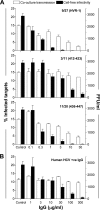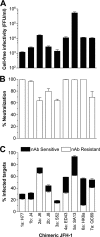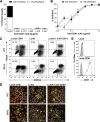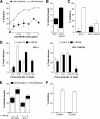Neutralizing antibody-resistant hepatitis C virus cell-to-cell transmission
- PMID: 20962076
- PMCID: PMC3014195
- DOI: 10.1128/JVI.01592-10
Neutralizing antibody-resistant hepatitis C virus cell-to-cell transmission
Abstract
Hepatitis C virus (HCV) can initiate infection by cell-free particle and cell-cell contact-dependent transmission. In this study we use a novel infectious coculture system to examine these alternative modes of infection. Cell-to-cell transmission is relatively resistant to anti-HCV glycoprotein monoclonal antibodies and polyclonal immunoglobulin isolated from infected individuals, providing an effective strategy for escaping host humoral immune responses. Chimeric viruses expressing the structural proteins representing the seven major HCV genotypes demonstrate neutralizing antibody-resistant cell-to-cell transmission. HCV entry is a multistep process involving numerous receptors. In this study we demonstrate that, in contrast to earlier reports, CD81 and the tight-junction components claudin-1 and occludin are all essential for both cell-free and cell-to-cell viral transmission. However, scavenger receptor BI (SR-BI) has a more prominent role in cell-to-cell transmission of the virus, with SR-BI-specific antibodies and small-molecule inhibitors showing preferential inhibition of this infection route. These observations highlight the importance of targeting host cell receptors, in particular SR-BI, to control viral infection and spread in the liver.
Figures






Similar articles
-
Neutralizing host responses in hepatitis C virus infection target viral entry at postbinding steps and membrane fusion.Gastroenterology. 2008 Nov;135(5):1719-1728.e1. doi: 10.1053/j.gastro.2008.07.018. Epub 2008 Jul 22. Gastroenterology. 2008. PMID: 18718838
-
Receptor complementation and mutagenesis reveal SR-BI as an essential HCV entry factor and functionally imply its intra- and extra-cellular domains.PLoS Pathog. 2009 Feb;5(2):e1000310. doi: 10.1371/journal.ppat.1000310. Epub 2009 Feb 20. PLoS Pathog. 2009. PMID: 19229312 Free PMC article.
-
Different requirements for scavenger receptor class B type I in hepatitis C virus cell-free versus cell-to-cell transmission.J Virol. 2013 Aug;87(15):8282-93. doi: 10.1128/JVI.01102-13. Epub 2013 May 22. J Virol. 2013. PMID: 23698298 Free PMC article.
-
Hepatitis C Virus Entry: Protein Interactions and Fusion Determinants Governing Productive Hepatocyte Invasion.Cold Spring Harb Perspect Med. 2020 Feb 3;10(2):a036830. doi: 10.1101/cshperspect.a036830. Cold Spring Harb Perspect Med. 2020. PMID: 31427285 Free PMC article. Review.
-
The hepatitis C virus and its hepatic environment: a toxic but finely tuned partnership.Biochem J. 2009 Oct 12;423(3):303-14. doi: 10.1042/BJ20091000. Biochem J. 2009. PMID: 19807698 Review.
Cited by
-
Exploiting hosts and vectors: viral strategies for facilitating transmission.EMBO Rep. 2024 Aug;25(8):3187-3201. doi: 10.1038/s44319-024-00214-6. Epub 2024 Jul 24. EMBO Rep. 2024. PMID: 39048750 Free PMC article. Review.
-
Hepatitis C virus: why do we need a vaccine to prevent a curable persistent infection?Curr Opin Immunol. 2015 Aug;35:137-43. doi: 10.1016/j.coi.2015.06.010. Epub 2015 Aug 1. Curr Opin Immunol. 2015. PMID: 26241306 Free PMC article. Review.
-
A novel monoclonal anti-CD81 antibody produced by genetic immunization efficiently inhibits Hepatitis C virus cell-cell transmission.PLoS One. 2013 May 21;8(5):e64221. doi: 10.1371/journal.pone.0064221. Print 2013. PLoS One. 2013. PMID: 23704981 Free PMC article.
-
Vaccines: a moving target.Nature. 2011 Jun 8;474(7350):S16-7. doi: 10.1038/474S16a. Nature. 2011. PMID: 21666730 No abstract available.
-
Long Non-coding RNAs in Hepatitis C Virus-Infected Cells.Front Microbiol. 2017 Sep 28;8:1833. doi: 10.3389/fmicb.2017.01833. eCollection 2017. Front Microbiol. 2017. PMID: 29033906 Free PMC article. Review.
References
-
- Acton, S. L., K. F. Kozarsky, and A. Rigotti. 1999. The HDL receptor SR-BI: a new therapeutic target for atherosclerosis? Mol. Med. Today 5:518-524. - PubMed
-
- Bitzegeio, J., D. Bankwitz, K. Hueging, S. Haid, C. Brohm, M. B. Zeisel, E. Herrmann, M. Iken, M. Ott, T. F. Baumert, and T. Pietschmann. 2010. Adaptation of hepatitis C virus to mouse CD81 permits infection of mouse cells in the absence of human entry factors. PLoS Pathog. 6:e1000978. - PMC - PubMed
-
- Burlone, M. E., and A. Budkowska. 2009. Hepatitis C virus cell entry: role of lipoproteins and cellular receptors. J. Gen. Virol. 90:1055-1070. - PubMed
Publication types
MeSH terms
Substances
Grants and funding
LinkOut - more resources
Full Text Sources
Other Literature Sources
Research Materials
Miscellaneous

